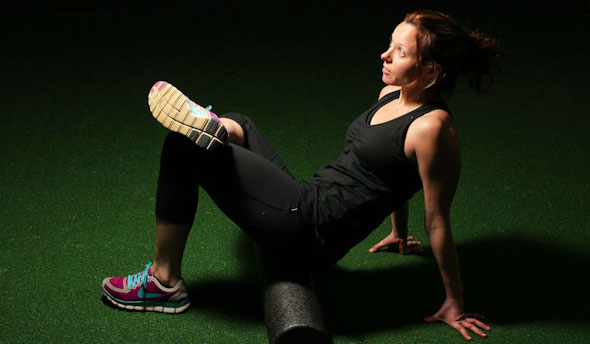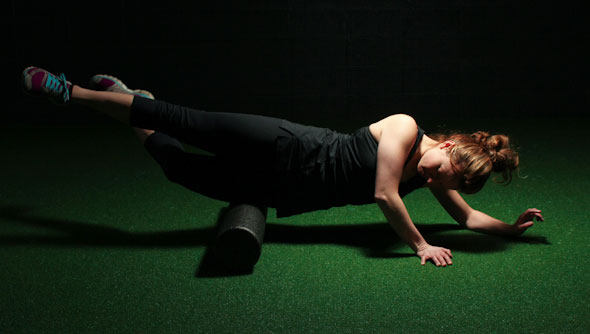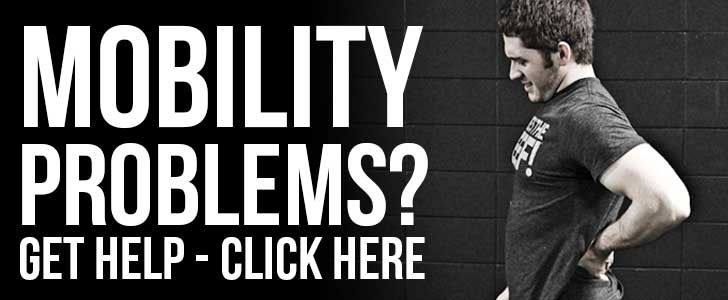Warming up is about preparing your body for the things you’re about to put it through. A good warm up makes exercise safer and more effective.
But if you don’t know what you’re doing, your warm up might be a waste of time, or, in the worst case, also detrimental to your goals. I thought it might be helpful if I wrote a basic post about warming up for people just getting into exercise.
This post is for people who:
- Just want a free warm up they can do before they exercise.
- Want to understand how to make their own warm up.
What Your Warm Up Should Accomplish
Here’s a general list of what you want your warm up to do for you:
- Get you in the workout mindset
- Turn the correct muscles on and off
- Access all of the mobility you will need
- Increase your body temperature
Get in the workout mindset
Once you kind of know what you’re doing when you get in the gym, your warm up becomes almost ritualistic. Doing your soft tissue work or dynamic mobility exercises tells your brain that you’re about to start working out and give it some feel-good hormones. You should be even more excited to train after your warm up than you were when you first walked into the gym.
Turn the correct muscles on and off
We humans are lazy. We want things to be easy, so we naturally take the path of least resistance. This is programmed into our minds because conserving energy makes it more likely that you’re going to pass on your genes to the next generation. Why would I drive to the bank to deposit a check when I can just do it on my phone?
The problem is that exercise is meant to be uncomfortable. If you do what feels easy, you don’t make progress.
Movement is the same way. Safer form or lifting technique is harder to do because it makes you more tired. So instead, you decide to compensate around this.
For example, if I am training a 40 year old woman who has never exercised a day in her life, she has no idea what “good form” is. She just knows that when she leans back with the weight, she doesn’t get as tired… but she does start to feel it in her back.
Now sometimes it’s not just about searching for “easy”, but for higher performance.
For example, think about those sick, sick people who exercise every day, bringing themselves to the limits of human performance each time. They default to the “easy” compensation so that they can do even more. They might know what “good form” is, but when they lean back at the top of their deadlift, they can get three more reps. They gauge the effectiveness of their workout by how much weight they can lift.
It’s easy to fall out of the right position, so we should do something before every workout to help prevent that. That’s where the warm up comes in.
Access all the mobility you will need
This point piggy-backs off of turning the correct muscles on and off.
When we default into the “easy” patterns that we discussed above, it can restrict our motion in certain directions. So before we get into our serious workout, we should use the warm up to remove those restrictions. This is where your resets come in (more on that below).
Once you’ve done your resets, you’ll want to cement that pattern into your brain with some movement. That’s where your dynamic mobility comes in (more on that below).
A subtlety to point out: these things are in an order for a reason. If you need more mobility for your workout, I want you doing your resets before your dynamic warm up.
Increase your body temperature
This one is simple. If you’re hotter, fluids move a little better. You pump more blood. Your knees don’t feel so achy.
Organizing Your Warm Up
I organize all warm ups in the same order:
- Soft tissue release
- Resets
- Dynamic mobility
- Warm up sets for main lifts
Each step is meant to accomplish something different.
Soft tissue release
Soft tissue work has become more and more popular over the last decade or two. When you get a massage, you’re having your soft tissue worked on. Foam rolling is another form of soft tissue work.

Since it has become so popular, there have been many different tools developed for soft tissue work. My favorite is something that wasn’t even made for soft tissue release: the lacrosse ball.
Basically, you pin the ball between your muscle and the floor or wall, then you just roll around like a masseuse would do to get rid of your “knots”. I usually recommend attending to a muscle for 20 seconds, then moving on. I try to limit soft tissue work to three muscles.

This “poor man’s massage” helps relax your body and may help you access some extra range of motion. It’s not, however, that powerful of a tool, so if you have to cut something from your warm up, soft tissue work should be the first to go.
Resets
Also known as “magic” to some people, resets are the main tool I use to unlock someone’s range of motion. A little extra motion allows you to do some cooler things out on the gym floor, that’s why I recommend most of our clients spend some time on resets before and after their workout.
The issue we run into is that the human body is complex. It’s not as simple as saying:
- Do this exercise
- MAGIC HAPPENS
- Now you’re all better!
The exercise that is right for one person is not necessarily right for the next person. So instead, I like to do some tests and then decide what exercises are more likely to help you (and we’ll do that soon, stay tuned).
Dynamic mobility
Resets usually have a calming effect, but you don’t want to be calm when you’re about to work out! We’re trying to raise your body temperature, remember? That’s where dynamic mobility work, or a dynamic warm up, comes into play.
The basic premise of a dynamic warm up is to work through all of your available ranges of motion. This reminds your brain that you have this motion available for your upcoming workout. If you keep accessing it, it will stick around longer.
Learning movement is just like learning in school: the more often you use something, the more likely you are to remember it.

Warm up sets for your main exercises
Once you’ve worked through all the mobility that you’ll need in your workout, it’s time to transition into your main exercises.
If you’re running, this means start with a slow jog and then speed up. Do this over a span of 5 minutes.
If you’re lifting weights, this means start with light weights on your main lifts and gradually work up to your training weight. You’ll want at least two warm up sets for an exercise, even if those two sets are just with an empty barbell.
This slow progression gets your body ready for what fitness professionals call “overload”. It prepares you for the stronger muscle contractions to come.
What about static stretching?
You may have noticed that I haven’t yet mentioned static stretching (that’s the kind where you reach and hold for time and then relax). That’s because I believe that most people doing it are making themselves worse because of it.
I’m not the biggest fan of static stretching. If you’re doing it because it makes you feel good, then I’m a little more okay with that. If, however, you’re simply doing it because it’s supposed to be good for you… I would suggest not doing it anymore.
Most people use static stretching to become more flexible, but they are already plenty flexible. The problem is that they can’t access their flexibility.
My warm ups are meant to teach someone to access this motion. Reset exercises unlock you, then dynamic mobility exercises make this motion stick a little better. I might still give some people static stretching, but it’s very uncommon.
If you think I’m crazy and want to read into it a little more, I wrote a deeper blog with example videos called Stop Stretching, You’re Wasting Your Time – Here’s What to do Instead.
Streamlining Your Warm Up
One of my biggest pet peeves these days is seeing a trainer program a really long warm up. The irony is that I used to program really long warm ups back when I was just beginning my training career. That just goes to show how much your experience shapes you.
Here are some tips to help streamline your warm up and save a little extra time:
- Have a plan going in
- Move from easier things to harder things
- Practice what you need to work on
Have a plan going in
You already understand this because you’re reading this post, but if you don’t have a plan, things are not going to run smoothly. Feel free to steal my plan below.
Move from easier things to harder things
You generally want your warm up to get progressively more difficult. The first way you can do this is by doing similar movements in different positions. For example:
- Do a few dynamic mobility exercises on the ground
- Then do a few on one knee
- Then a few while standing
Another way you can progress your warm up is through the speed of your movement. For example:
- Start by holding a position for a number of breaths
- Then move around slow and controlled
- Then do some “track-like” warm up exercises where you’re jumping or skipping around
You can also consider where everything is organized in your gym so you don’t have to run all over the place to find, setup, and teardown different warm up implements like bands or boxes or whatnot.
Practice the things you need to work on
Since you are going to do your warm up every time you go to the gym, the end of it is a great place to put a movement that you need to practice.
For example, if I have someone who has trouble controlling their center of mass when they squat, I might tell them to do a few sets of Goblet Squats with a Heartbeat before moving on to their main exercise for the day.

Aside from just driving home a new movement pattern, maybe there’s an exercise that you really like to do every day to see if you can do it better.
For example, one of my female clients wants to do a Turkish Get Up with a 95lb dumbbell (and she’s almost there). So I’ve programmed a couple sets of this exercise at the end of her warm up so that she can keep practicing it. She understands that she won’t do more weight each and every time she’s in the gym, but it keeps her happy and hungry to get better.

Here’s a Warm Up for You
Up until this point, I’ve tried to give you a basic understanding of warm ups so that you have the knowledge to make your own if you know what kind of movement limitations you should address.
Ultimately, however, most people aren’t at the point. And that’s why I recommend getting a coach to help you learn things the right way.
Since I’m not there right now to help figure out the fastest and most effective exercises for you, I’ve made a really short assessment that you can do on your own. Depending on what you find there, you will be sent to one of three different warm ups. This way, we can keep things a little more personalized for your needs.
Here’s a link to a short movement assessment.
- Click the link above^^^
- Click on the “FILE” tab, then select “Make a Copy…”
- Click “OK”
- You should be able to edit things in the new file now. Click the links for each of the tests to find out how to perform them.
- Perform the tests and fill in your results in the yellow drop-down boxes on the spreadsheet
- For example, if you can’t bring either leg to the table while feeling your inside thigh muscle, mark NO for both of the tests in the first row.
- If you can keep your knees locked straight and touch your left toes and your right toes, mark YES for both tests in the second row.
- After you’ve filled in all four test results, the spreadsheet will link you to one of three warm up routines that I’ve written. This is the one that is best-suited for you.
- Download that warm up (it has links to each exercise I want you to do so you’re not flying blind).
- Send it to your training partner so they can have a warm up as well.
If you’re not into all that testing and stuff, you can just do a base level warm up that does some good for everyone. Try this one out.
Summary
Here’s a general list of what you want your warm up to do for you:
- Get you in the workout mindset
- Turn the correct muscles on and off
- Access all of the mobility you will need
- Increase your body temperature
Ordered stages of the warm up:
- Soft tissue release
- Resets
- Dynamic mobility
- Warm up sets for main lifts
Here are some tips to help streamline your warm up and save a little extra time:
- Have a plan going in
- Move from easier things to harder things
- Practice what you need to work on
If you missed it above, here’s a link to the short assessment to find a personalized warm up and, if that doesn’t tickle your fancy, here’s a link to a generic warm up.
Go ahead and give that a try before your next workout.
If you have questions, sign up for my email list and reply to your welcome email to ask me anything. These generic warm ups don’t work for everyone, so I can help you find some modifications if you need them.
Thanks for reading!
-Lance
P.S. If you liked this article, send it to your sister! (or whoever else needs some exercise guidance)
Other articles you might like:
- Mom’s, Here’s How to Get Your Daughter Interested in Exercise
- Unlocking the Secrets of Willpower: How Exercise Helps You Stop Eating Dessert
- Keep The Weight Off Forever
Photos courtesy of Allen Tucker


Add some color to this commentary.